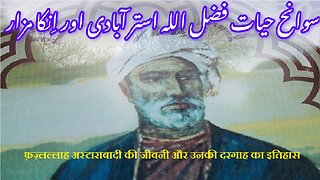Premium Only Content

Abu Sulaiman al-Tai अबू सुलेमान अल-ताई ابو سلیمان داؤد ابن نصیر الطائی اور مزار کی تاریخ
@islamichistory813 #sufisaint #culturalheritage #biography #Abusulaiman #dawudibnnusair #altai #islamicmysticism #islamicphilosophy #shrine #historicalfigures
Biography of Abu Sulaiman Dawud ibn Nusair al-Tai and the history of his shrine.
Dekhti Aankhooon aur sountay kaanoon ko Asslamoalaikum, sisters, brothers friends and elders, in informative series videos of Islamic ascolars, sufisaints, cultural heritages, islamic philosophys, islamic mysticisms and historical figures. today we are describing biography of Abu Sulaiman Dawud ibn Nusair al-Tai and the history of his shrine.
Abu Sulaiman Dawud ibn Nusair al-Tai, usually referred to as Dawud Tai, was an Islamic scholar and Sufi mystic. He resided in Kufa and was a prominent student of Abu Hanifa. His disciples included many influential personalities of Islamic mysticism, e.g., Maruf Karkhi. His master was Habib al-Ajami
Tai studied hadith and fiqh for many years with Imam Azam Abu Hanifa in Kufa, and being one of his favorite students, he reached a high level in science and fiqh. He also had an effective speaking ability. He was probably being a bit offensive too. As a matter of fact, when he hit someone with his stick, his teacher Abu Hanifa had to scold him: "Abu Suleiman, your hand and tongue are growing long!" Dawud al-Tai was highly affected by this warning and did not speak in the last year of his studentship; he neither asked nor answered any questions. Although al-Tai was "the most fluent speaker of his time and the one who knew Arabic best", and "one of the leading imams in fiqh and opinion", he threw his books into the Euphrates River for some reasons that are shown differently in the sources and retreated to zuhd and worship. He completely distanced himself from the public and worldly affairs, locked himself in his house, and joined the congregation only at prayer times.
Among the people he met were Fudayl b. Iyaz, Jafar al-Sadiq and Ibrahim ibn Adham. He also met the Abbasid Caliph Harun al-Rashid according to Imam Abu Yusuf. According to Fariduddin Attar, Fudayl b. Iyaz was proud to have had the honor of meeting him twice. One of his contemporaries in describing his greatness said, "If Dawud al-Tai had lived in the Age of Bliss [the Holy Prophet's time], the Qur'an would certainly have mentioned his zuhd and taqwa."
Maruf Karkhi, his best-known disciple, introduces his master by saying, “I have never seen anyone who does not value the world as much as Tai.” The fact that he used the expression "May your death be your celebration" while wishing someone well and that he saw death as salvation from the prison of this world reflects the characteristic feature of the life of asceticism at that time. This optimistic understanding about death turned into Shab-i Arus (Wedding Night) in later periods. Dawud al-Tai, who bequeathed his grave to be built in a deserted place and thus wanted the seclusion in the world to continue there, used to attach great importance to worship, but said that one should not see one's worship as perfect and should not trust their worship. According to him, the worship of a person who does not have generosity and muruwa is incomplete. As a matter of fact, after he turned to Sufism, he spent the money left by his father with his friends.
Al-Tai died while reading the Qur'an in his house, which was in ruins. In the sources, it is narrated that he fell ill and died due to the strong influence of a verse about hell that he recited one night until the morning
Abu Sulaiman Dawud ibn Nusair al-Tai was born in the early years of Islam, with most sources agreeing that his birth occurred around the early 8th century, though precise dates remain uncertain. He is often associated with the region of Kufa, a city in present-day Iraq that was a center of learning, political activity, and theological debate in the early Islamic period. Kufa, a prominent city during the Umayyad and Abbasid periods, played a key role in the development of Islamic thought, and it was here that many early Muslim scholars, theologians, and mystics, including al-Tai, were nurtured in their intellectual and spiritual journeys. The city itself had a diverse population, with Arabs, Persians, and others living in relative proximity, creating a vibrant intellectual and cultural milieu. Kufa’s significance as a center for early Islamic scholarship is vital to understanding the intellectual environment in which al-Tai was raised.
Despite the lack of a great deal of information about his early life, it is believed that Dawud al-Tai came from a noble or respected family. His upbringing would have exposed him to the teachings of the Qur'an, Hadith (sayings of the Prophet Muhammad), and the early Islamic traditions that were taking shape in the centuries following the Prophet’s death. Kufa was a hub for Islamic jurisprudence and theology, and it is likely that al-Tai studied under the guidance of renowned scholars of the time, especially those who focused on Islamic mysticism and asceticism.
The exact date of Dawud al-Tai’s death is not definitively known, but historical accounts place it in the 8th century, possibly around the latter half of the century. Given his association with Kufa, it is widely believed that he died there, although some sources suggest he may have also spent time in other regions, such as Baghdad. The absence of a specific recorded year of death is not uncommon for figures from the early Islamic period, especially those who did not hold official political positions or roles within the central power structures of the time.
Dawud al-Tai’s death marked the end of an era for the early Sufi movement. His life had been dedicated to asceticism, self-discipline, and spiritual devotion, and upon his death, he was widely mourned by his followers and the broader community of Sufis and scholars. His influence, particularly in shaping the ethical and spiritual dimensions of Sufism, continued to be felt long after his passing. Al-Tai was remembered as a figure who strived to purify the soul through detachment from worldly desires and attachment to the love of God, and his death did not diminish the impact of his teachings.
Dawud al-Tai’s shrine, like many early Islamic figures, became a place of reverence and pilgrimage after his death. It is believed to be located in the city of Kufa, in present-day Iraq. The shrine of Dawud al-Tai, much like those of other early mystics and ascetics, serves as a site where pilgrims and followers come to honor his memory, seek spiritual solace, and reflect on his teachings.
The shrine’s location in Kufa is significant, as it places al-Tai’s final resting place in the heart of an important intellectual and spiritual center in the early Islamic world. Kufa, during al-Tai’s time, was a city of great theological diversity, where debates on the nature of faith, practice, and spirituality flourished. The city’s connection to early Islamic figures, including Imam Ali ibn Abi Talib, the fourth caliph and first Imam in Shia Islam, adds further significance to the location of al-Tai’s shrine.
Over the centuries, the shrine of Dawud al-Tai has become a symbolic and spiritual landmark for those who follow the path of Sufism. Although the shrine’s structure may have changed over time, as is often the case with historical religious sites, it remains a place of reverence for those who seek to connect with the spiritual legacy of this early mystic. The significance of the shrine lies not only in its association with al-Tai himself but also in the broader history of Sufism and the way in which shrines of revered figures have become focal points for the practice and propagation of mystical spirituality.
The precise details surrounding the construction of Dawud al-Tai’s shrine are not clearly documented. Like many religious shrines, especially those dedicated to early Islamic figures, the construction and maintenance of al-Tai’s shrine may have been a gradual process, influenced by local communities and rulers over time. Islamic shrines were often built or expanded by various rulers, religious leaders, or local communities who sought to honor the memory of important figures in Islamic history. In many cases, the building of a shrine would be initiated by local believers or prominent figures within the Islamic community, who sought to preserve the legacy of a revered scholar, mystic, or saint.
In the case of Dawud al-Tai, the construction of his shrine likely took place centuries after his death. As with many early Islamic figures, it was common for later generations to erect shrines or memorials as a way of ensuring that the memory of such figures would live on and continue to inspire devotion and reflection. The shrine could have been built during the early Abbasid period, or it might have been constructed or renovated during the period of the Safavid or Ottoman empires, both of which were influential in the region and played a role in the promotion of Islamic mysticism and the veneration of saints and scholars.
The maintenance and care of the shrine would have been an ongoing process, with various local rulers and communities contributing to its preservation. These shrines, often located in key religious centers, became places where people would visit to offer prayers, seek blessings, and show respect to the figure buried there. Such shrines became a focal point for the spiritual lives of those living in the surrounding areas, and the figures interred within them were venerated as spiritual guides and protectors.
Abu Sulaiman Dawud ibn Nusair al-Tai was a significant figure in the early history of Islamic mysticism, and his teachings on asceticism, the love of God, and the purification of the soul had a profound influence on the development of Sufism. Born in Kufa, Iraq, during the early years of Islam, he contributed to the spiritual life of the Muslim world through his devotion to self-discipline and moral integrity. Though the exact date and circumstances of his death are uncertain, it is widely believed that he died in Kufa, and his final resting place in the city became the site of a revered shrine that attracts pilgrims seeking to honor his memory and reflect on his teachings.
The shrine of Dawud al-Tai, located in Kufa, remains an important spiritual site for those following the Sufi tradition. Though the construction of the shrine itself is not fully documented, it is likely that it was built or expanded over time by various Muslim communities, possibly during the Abbasid or later periods. This shrine stands as a testament to the lasting impact of al-Tai’s life and teachings, and it continues to be a place of reverence for those who seek a deeper connection to the spiritual practices of early Islam.
With that allow us until tomorrow, tomorrow we will be described biography of Islamic Scholar Sufi Sanit Abu Sulaiman Dawud ibn Nusair al-Tai and the history of his shrine.
================================================
-
 6:57
6:57
ISLAMIC HISTORY
3 hours agoFazlallah Astarabadi | फ़ज़लल्लाह अस्तराबादी | فضل اللہ استرآبادی کی سوانح عمری اور مزار کی تاریخ
1 -
 1:58:39
1:58:39
The Confessionals
2 days ago744: Inside the UAP Intel Loop
4.46K -
 1:04:01
1:04:01
Timcast
3 hours agoTrump Just NUKED Global Economy, Tariffs Ignite Trade War, Markets COLLAPSING
157K138 -
 1:54:08
1:54:08
Steven Crowder
5 hours agoLiberation Day: How Trump's Tariff Strategy will Reset the Global Order
354K211 -
 1:58:23
1:58:23
The Charlie Kirk Show
3 hours ago“Liberation Day” Reaction + Military Standards + Tariff History | Thibeau, Hanson | 4.3.25
74.1K15 -
 LIVE
LIVE
SternAmerican
1 day agoIntegrity in Action call With Steve Stern and Raj Doraisamy Thursday, April 3rd at 2:00PM EST
466 watching -
 1:39:41
1:39:41
Rebel News
2 hours ago $1.89 earnedTrumps new global tariffs, Poilievre and Carney respond, Tamara Lich verdict | Rebel Roundup
26.4K5 -
 1:06:19
1:06:19
TheAlecLaceShow
3 hours agoTrump Tariffs Take Effect | Alec Lace in the Rose Garden | Guest: Jim Pfaff | The Alec Lace Show
17.9K1 -
 LIVE
LIVE
Major League Fishing
2 days agoLIVE! - MLF Bass Pro Tour: REDCREST - Day 1
4,419 watching -
 LIVE
LIVE
Viss
3 hours ago🔴LIVE - How to Continuously Stack Win in Solo PUBG!
261 watching